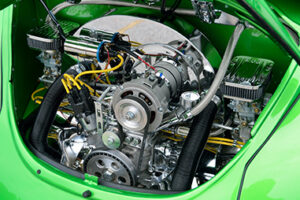The history and future of the E-vehicle
Over the past year, many industries faced the urgent need to overcome unforeseen hurdles in order to adapt to the changing landscape this world-wide pandemic has presented. The electronics industry, for example, is still evolving at a rapid pace, even though it faces shortages of components, amongst other challenges. This is no different for the automotive industry. The reduction in volume of cars produced may seem like “pumping the breaks”, but the gears have shifted to jumpstarting other less active areas in the industry. E-Vehicles (EVs) are now the focal point of research and development
The rise of the E-Vehicle

Electric cars are thought by most to be new and cutting-edge technology, but, in fact, they have been around since the late 19th century. In 1881 Gustave Truove invented the first practical electric car, but due to a lack of documentation, the Flocken Elektrowagen, designed by German inventor Andreas Flocken, is regarded as the first real electric car. The revolutionary innovation of the electric car made it very popular at the time. Unbeknownst to many, about 38% of the cars in the US in the early 1900’s were actually electric.
In the following years, advancements in internal combustion engines and electric starters, along with the low cost of fuel, caused customers, and consequently the auto industry, to shift away from electric cars to the more efficient internal combustion engine vehicles.
The biggest challenge for E-vehicles
Just as in the past, the main challenge electric cars face today is their efficiency:
- Charging speeds
- Mileage
- Charging stations
- Battery Life
In the early 2000’s, new types of motors, batteries, along with the emergence of metal-oxide semiconductor (MOS) technology led to the development of the modern electric car. Generally speaking, two main types of E-vehicles that have delivered tangible sales to date: battery electric vehicles (BEVs), which are plugged-in to recharge, and plug-in hybrid electric vehicles (PHEVs), that use a combination of battery power and liquid fuel to operate.
A main problem so far has been the retail cost of these vehicles, along with the issue of mileage, but that could be changing sooner than you think. Now, with the revolutionary changes in the field of energy storage devices, the industry is being driven towards EVs. Li-ion battery technology is progressing, but the next game-changer will be solid-state and lithium-silicon technologies.

What is changing?
Customers are driven towards E-vehicles for:
- Cost-effective transportation
- Tax free solution to emissions regulations and laws
- Safety & comfort through innovations and electronics integrations
- Eco-friendly thinking
Wireless battery management system
The introduction of the wireless battery management system is one of the key enablers for the broader deployment of electric cars. Eliminating the need for traditional wiring increases space for batteries and at the same time makes the design process easier and more flexible. It helps to avoid the need of redesigning complex wiring diagrams that fit into every different vehicle and ensures scalability in battery design.
This wide use of batteries in e-vehicles directed the electronics designers towards a new generation of electric charge monitoring devices. Constant wireless monitoring of the batteries ensures they remain protected, making the vehicle and passengers safer, along with boosting mileage, battery life-span, and overall performance.
Introducing IoT and AI to E-vehicles
The lack of charging stations presents an issue but IoT presents a solution. With the use of IoT, charging stations remain connected and easily accessible for remote support and maintenance. Smart charging and demand-side management (DSM) improves the cost-effectiveness of the charging station infrastructure, resulting in more charging stations, making E-vehicles more attractive and convenient in the modern world.
Passenger safety is key, and the integration of AI in vehicles demonstrates that. AI can predict and correct movements of the vehicle, and even avoid surrounding obstacles, like other vehicles, pedestrians, animals, etc.
The application of this technology multiplies when it comes to E-vehicles, resulting in many more sensors and electrical components for measuring a variety of input data (temperature, force, CO2, etc.) and counteracting accordingly in emergency situations.
The automotive industry is already taking strides towards autonomous driving, and the continuous research has resulted in better performance over time. We are not far from having easy access to driverless transportation. This can already be seen in some cities with driverless busses and other means of autonomous transportation.
So, why now?

Safety and health have become top priorities in 2021. Systems for checking health issues, sanitizing technologies, remote control and access of houses and workspaces, etc. have made the difference in the Covid-19 health crisis. So, why not implement these technologies in a car, keeping you safe, while at the same time helping the environment and lowering the cost of transportation?
Markets shift towards what is most attractive, and E-vehicles are attractive and less noisy while providing more user interaction with the vehicle. Companies with a fleet of vehicles can now control and monitor their fleet with the utilization of improved software and integrated hardware, resulting in greater interaction with the fleet, increasing the company’s capabilities, while decreasing costs and enhancing quality.
E-vehicles have returned and are here to stay
Many countries are just now setting goals for 2030-2040 for all new car sales to be electric, but Norway set the same goal years ago and hopes to accomplish that goal by 2025. As technology continues to evolve, the possibilities presented in E-vehicles reach far beyond what we thought, even 2-5 years ago, and it is just a matter of time before we realize it.
Our Process
We understand that success begets success and strive for continuous improvement at every level. Applying agile approaches and the latest technological advances, we remain responsive and efficient in our processes, in our manufacturing, and in our service to you.
Ark Electronics is a leading integrated manufacturing solutions provider serving the fastest-growing segments of the global Electronics Manufacturing Services (EMS) market. Recognized as a technology leader, Ark Electronics provides end-to-end manufacturing and engineering solutions, delivering superior quality, support, and delivery services to Original Equipment Manufacturers (OEMs) primarily in the consumer, IoT, industrial and automotive markets. To learn more, please Contact Ark or Request a Quote




